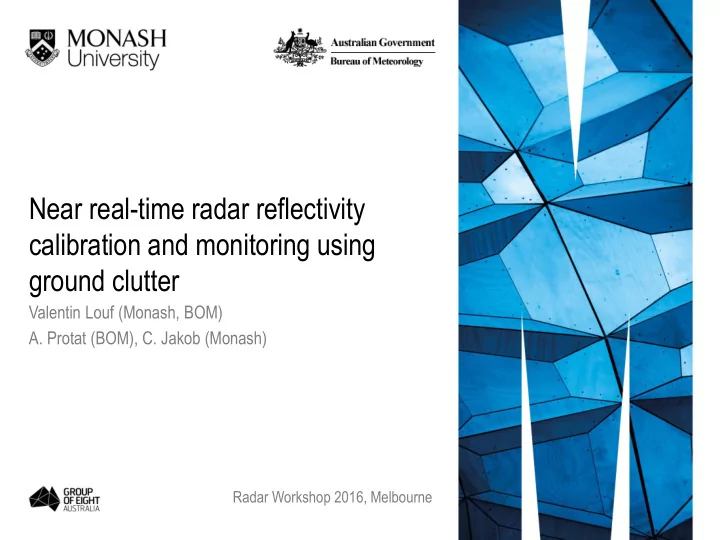

Near real-time radar reflectivity calibration and monitoring using ground clutter Valentin Louf (Monash, BOM) A. Protat (BOM), C. Jakob (Monash) Radar Workshop 2016, Melbourne
Ground clutter? How about no! Ground clutter is responsible for: Spurious signal. Bias reflectivity. Skew Doppler velocity estimates. What we (traditionally) want: Identify and eliminate ground clutters. 2 Radar Workshop 2016, Melbourne
Can a constructive use of ground clutter be made?
Can a constructive use of ground clutter be made? Study of beam patterns (Rinehart and Frush, 1983). Estimation of the attenuation caused by rainfall (Delrieu et al., 1997). Estimation of the refractive index of air (Fabry, 2003). Estimation of the topographic structure (Mesnard et al. 2003) Monitoring of radar calibration, proposed by Rinehart in 1978. Figure from Louf et al (2015) 4 Radar Workshop 2016, Melbourne
Monitoring of radar calibration. Not a new technique… but not a common one. 2008: 1960: Atlas and Silberstein et 2015: Wolff et Mossop al. al. 1978: Rinehart 2009: Marks et al. 5 Radar Workshop 2016, Melbourne
How can we use ground clutters? The meteorological radar equation: 𝑎 𝑛 𝑒𝐶𝑎 = 10 log 10 𝑄 𝑠 + 20 log 10 𝑆 − 10 log 10 𝐷 With: – 𝑎 𝑛 : reflectivity, – 𝑄 𝑠 : echo power, – 𝑆 : the range. – 𝐷 : the weather radar constant. 10 log 10 𝐷 represents the radar sensitivity (in dB). 6 Radar Workshop 2016, Melbourne
How can we use ground clutters? Clutter is due almost entirely to human-made structure: – Building microphysics do not change drastically with time: Δ10 log 10 𝑄 𝑠 = 0 – It is unlikely that the range itself changes significantly over time: Δ20 log 10 𝑆 = 0 Therefor: Δ𝑎 𝑛 = Δ10 log 10 𝐷 The variations of ground echoes reflectivity are directly linked to the variations in radar calibration. 7 Radar Workshop 2016, Melbourne
How can we use ground clutters? Construct a clutter map. – Select all PPIs for a day without precipitation (within the 5, or 10km of the radar). – Keep the echoes with a reflectivity above 50 dBZ and a frequency of occurrence superior to 50%. Apply the mask. – Collects the clutter area reflectivity for a given moment/day/month. – Computes the probability density function (PDF) calculate the 95 th percentile of reflectivity. 8
Computation of the Relative Calibration Adjustment (RCA) offset The RCA is defined as being: 𝑆𝐷𝐵 𝑒𝐶 = 𝐷𝐸𝐺 95𝑢ℎ (𝑎 𝑐𝑏𝑡𝑓𝑚𝑗𝑜𝑓 ) − 𝐷𝐸𝐺 95𝑢ℎ (𝑎 𝑑𝑚𝑣𝑢𝑢𝑓𝑠 ) The RCA value is the adjustment (in dB) needed to obtain agreement to the baseline. 9
Why using the cumulative distribution function? 10
The results for CPOL.
The RCA on CPOL: average seasons 12
The good 13
The bad 14
The ugly A software update that was not suppose to change anything. 15
Back to normal 16
Long-term evolution of calibration 17
« Since it is unlikely that the terrain itself changes significantly over such periods of time [a day], and if other explanations such as variations in radar calibration or electromagnetic properties of the ground can be ruled out, one must conclude that it is the medium in which the radar wave travels that experiences these changes, in this case, air. » Fabry (2003) in « Meteorological Value of Ground Target Measurements by Radar » 18
Diurnal cycle of the RCA 19
What future for this technique?
Implementation on Indian radar’s network Amar Jyothi’s work. 21
Test on operational radars (Melbourne). 22
Conclusions Conclusion on the radar technique: – Calibration – Monitoring – Easy checking on large dataset. Conclusion on the atmospheric research: – Clutters are not noise, they contain valuable informations! 23
The new CPOL dataset
The new CPOL dataset (delivery in January) Level 1: 3D: 3D winds, hydrometeor classification. – Raw data calibrated and filtered data. (ZH, ZC, ZDR, Level 3: KDP, PHIDP, RHOHV, WIDTH) Climatology. Polar. (Every 10 mins) Area mean rainfall, Peak Cartesian. (Daily mean) rainfall 99.5 th percentile), Area fraction of convective Level 2: and stratiform, Area fraction vs height, Stats on – 2D: Conv/strat, Z(2.5 km), wind and convective mass rainfall, 0dBZ, cloud top flux … height 17 dBZ, 20 dB, 40 dB 25
Recommend
More recommend